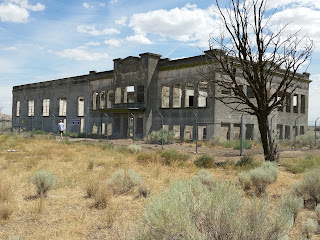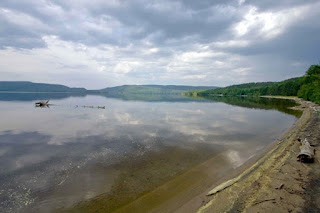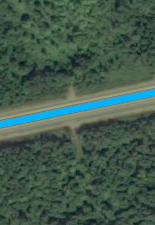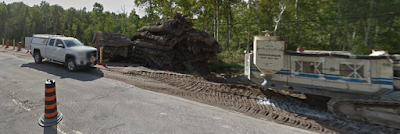 |
| a tree-filtered glimpse of Muskrat Lake |
2,618 miles
 |
| whitewater rapids on the Ottawa River |
July 29 - The Ottawa
River in this area is full of whitewater rapids, so traditional canoe travel
was impossible.
 |
| Algonquin family with transport canoe |
The native Nibachis, an
Algonquin-speaking tribe, and the first French explorers, including Samuel
Champlain, followed a 13-mile portage route from east of the Roche Fendu set of
rapids, overland to the southeastern end of Muskrat Lake (now Cobden), and then using the Muskrat River system to
continue to Mirimichi (now Pembroke). Later, lumbermen also used this route.
 |
| Muskrat Lake shortcut |
The Government of Upper Canada commissioned the famous surveyor and explorer David Thompson to find out whether a canal route was feasible, but did not proceed with that idea. Then a private entrepreneur, Jason Gould, set out to build “Gould’s Line”, which combined overland and lake travel along that same route.
 |
| "corduroy road" of logs |
A rough “corduroy road” made of logs was laid out from the lake to the Ottawa River below Calumet Island, along which stage wagons carried freight and passengers. Row boats on Muskrat Lake conveyed passengers and goods to Pembroke, replaced later by a small steamboat. When the line was complete in the 1850s, the entire trip – from Ottawa to Rapides des Joachims and back – could be accomplished in three days.
 |
| Ottawa River steamship, 1868 |
In 1868, a
steamship company published a brochure titled “Tourists and Travelers Guide to
the Upper Ottawa” and in 1984 a local historical article, written by Clyde C. Kennedy and published in the Pembroke Observer, summarized the description of this mid-Victorian
mode of deluxe travel:
First class omnibuses left the various Ottawa city hotels every morning during the week to connect at Aylmer with steamers leaving the place upon the upward voyage at 8:30 a.m. The passengers enjoyed the novelty of eating each meal during the day on a different vessel. They breakfasted on board the “Ann Sisson” shortly after leaving Aylmer, dined upon the “Alliance” and had tea in the course of the trip from Cobden to Pembroke on the “Jason Gould” or “North Star“.
The creature has become a tourist attraction and a cultural mascot of the area, much like Paul Bunyan or Cordwood Pete (March 1 – Fosston, Michigan). Mussie is portrayed on signs welcoming visitors to Cobden and by a statue (with only 2 eyes) in front of the hardware store in the village.
The statue of Mussie is given seasonal accessories to mark holidays, like reindeer antlers & a Rudolf red nose for Christmas.
Visitors to Muskrat Lake search for Mussie in the lake, but no one has captured evidence of its existence.
Muskrat Lake's ecology encourages the growth of underwater weeds that can entangle swimmers and boat propellers. Visitors flock to the lake to catch impressive pike, walleye, pickerel, and lake trout, even though eating the fish is not recommended due to high levels of phosphorus and green algae in the water.
info & images:
Wikipedia.org
Google Images






























